What Is A Proof Coin?

What Is a Proof Coin? A Definition and How to Identify Proof Coins
In the modern era, a proof coin is generally a coin that's been specially struck for the collector market. It looks pretty much the same as a normal coin but has some subtle technical differences that aren't easy for non-collectors to identify.
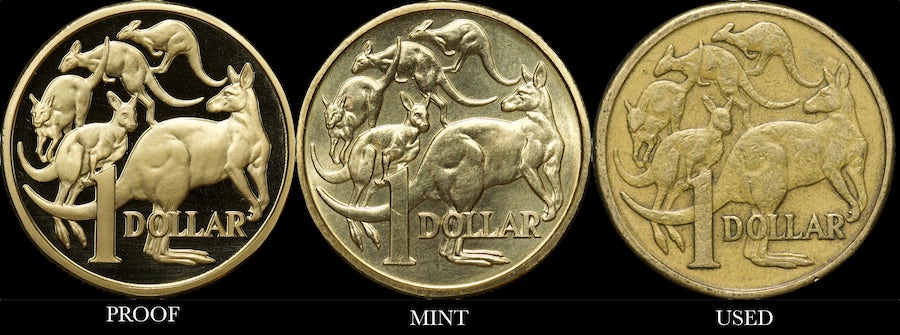
Proof Coins / Uncirculated Coins / Used Coins
Sharper detail, squared rims, mirrored background and frosted relief - all of these are characteristics that are normally seen on a modern proof coin.
Proof coins are struck in lower numbers than circulating coins, and they also look a lot better, so coin collectors are prepared to pay a lot more for them. Some collectors prefer collecting proof coins as they believe they look a lot better than circulated coins.
A Brief History of Proof Coins
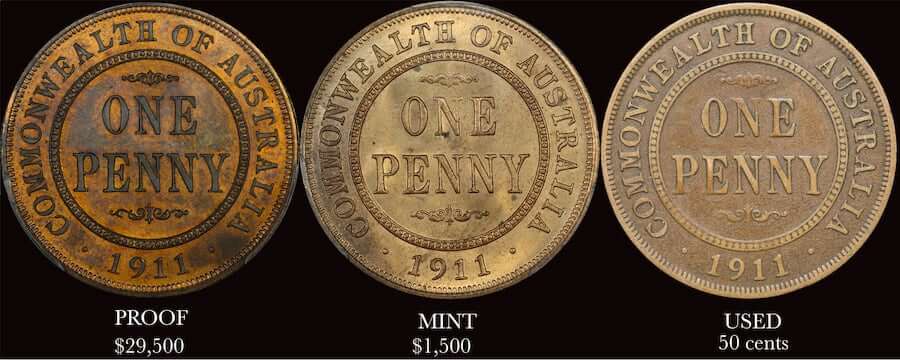
Proof Coin / Mint Coin / Used Coin
Before Australia's mints began making commercial quantities of proof copper, gold and silver coins specifically for coin collecting, proof coinage was struck for two very exclusive purposes - to verify that the coin press was working as intended (hence the term proof) and was going to make perfect coins and also to strike coins for archival and presentation purposes.
In Australia before the 1960s, proof coins were occasionally struck for the collector market but were more often only ever struck for archival and presentation purposes. The technical characteristics of these coins will differ according to year, denomination and mint, which is why there can be a lot of confusion about what is proof and what is not!
Some people will see photos of a coin worth thousands of dollars on the internet, yet when we tell them their coin is completely different, it can obviously take them a while to accept what we're saying.
The question of what is a proof coin gets asked all the time - picture Fred who's been digging in the garden on a Saturday afternoon and he unearths an old penny.
He can see that the date on the penny is 1911, so Fred thinks "Gee, that's a pretty old coin, I wonder if it's worth something?" Fred then pulls out his phone, does a Google search and sees one advertised by a rare coin dealer in Fremantle for $29,500!
Fred suddenly loses interest in fertilizing his roses and rings the coin dealer in Fremantle to see what he can get for his newly found rare coin. Fred's normally a pretty sensible guy, but with the prospect of thousands of dollars on offer, the conversation generally goes something like this:
A: "Sterling & Currency, this is Andrew."
F: "G'Day Andrew my name's Fred how are you I've just found this coin it's a 1911 penny what will you give me for it?"
A: "I'm pretty good, thanks for asking Fred. So what can you tell me about this penny you've got?"
F: "Well I was just digging in the garden fertilizing my roses and I came across it."
A: "Well Fred, I'm at a slight disadvantage in that I can't see your coin, but going on the information you've given me I reckon that coin's going to be flat out being worth any more than 50 cents. It's not rare in average condition."
F: "Well this one's not average, it's pretty good - you can see all the details on it and that. I've got some tomato sauce so I can polish it up if you want. And I know you're selling one for 30 grand by the way."
A: "Jesus no! Don't polish it up Fred, just leave it as it is. That coin you've seen on our website is proof, it's one of only 2 known and is different to the coins struck for circulation."
F: "Well I reckon this is the second one because it looks exactly like the one you've got."
And this is where it gets really difficult for the non-collector to understand. (Just like it's hard for Andrew to understand how to fertilize roses / change a sparkplug, the list goes on.)
How Do You Tell If A Coin Is A Proof?
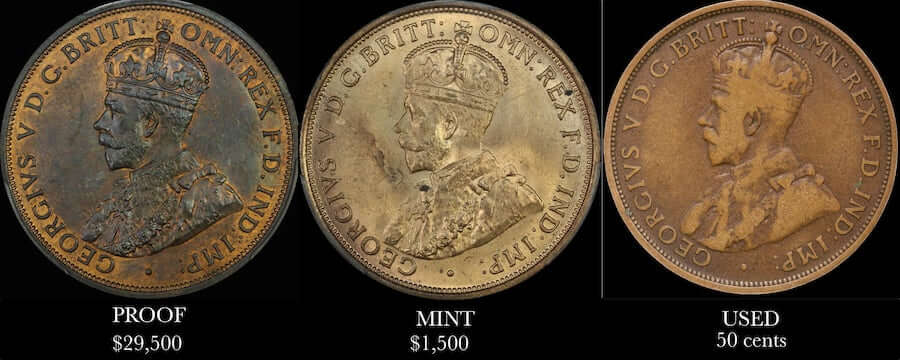
Proof Coin / Mint Coin / Used Coin
Modern Australian proof coins are fairly easy to distinguish from circulating coins - they have a frosted relief against a mirrored background. Older Australian proof coins (pennies and such) are much harder to detect.
When someone rings us and in the course of the conversation we find out they have a coin they believe is proof, we first ask them to check the the condition of the coin - "Is it in mint condition?" They'll generally respond with something like "It's pretty good, you can still see all the design and that. I mean, it's not bent or anything." If a coin doesn't look like it's in mint condition (brand new, or exactly as it did when it left the mint), then there's no way it'll bring the same price as an attractive proof coin.
If the coin does look like it's in mint condition, then we generally get them to either bring it to us for an inspection or let them know they should take it to a dealer that has expertise in identifying them. If they live in the bush or want to do their homework before heading in to see a dealer, there is an abundance of collector groups and pages on social media that have members who are more than happy to give their opinions about such things. Their expertise doesn't always match their enthusiasm, so you should take whatever they say with a grain of salt, but at least it's a start.
The Different Types of Proof Coins
Australia's mints now strike a wide range of commemorative coins for coin collectors:
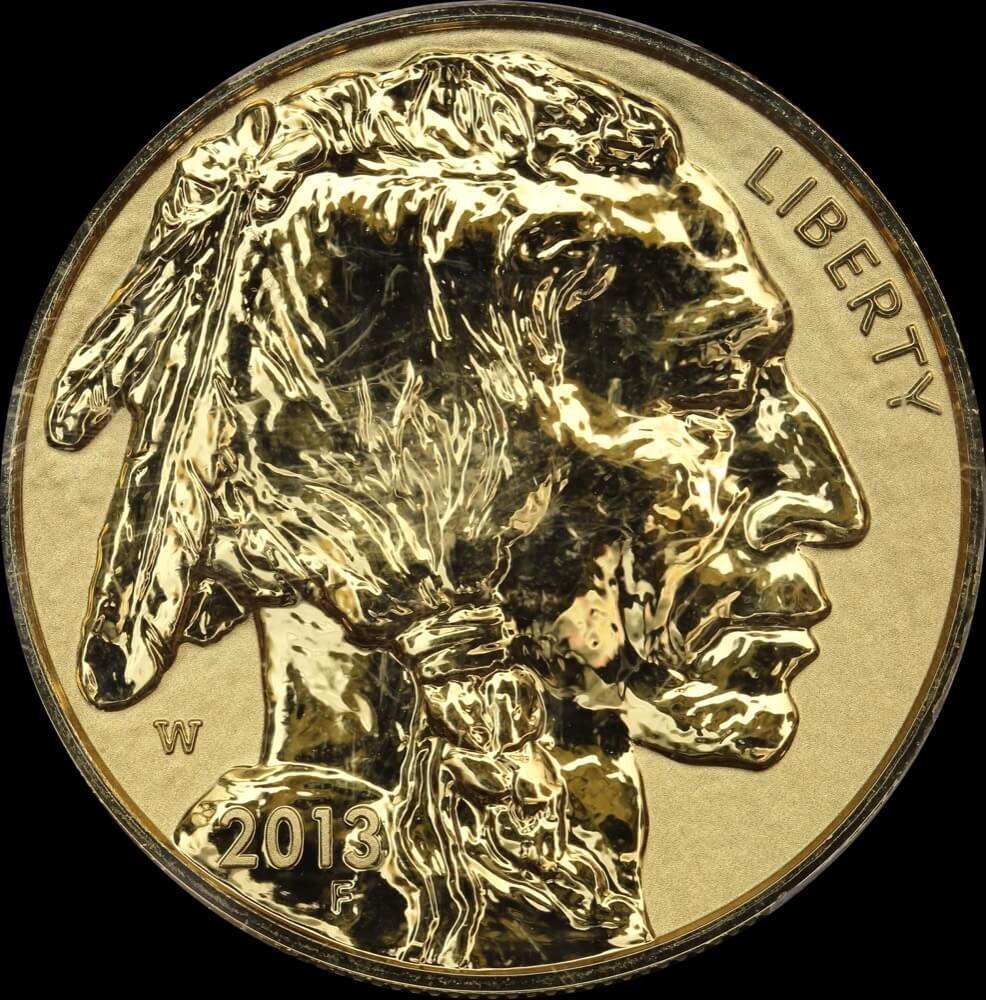
USA 2013 $50 Reverse Proof Buffalo
Reverse proof coin - This type of proof coin has a mirrored relief and a frosted background;
High-relief proof coin - This type of proof coin has a relief (the design)much higher than standard proof coins;
Gilt proof coin - This type of proof has gold plating on the relief, making it stand out against the mirrored background;
Coloured proof coin - This type of proof coin has colours impressed on the relief, making it stand out against the mirrored background;
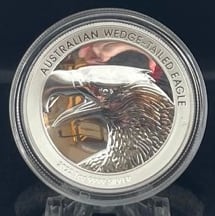
High Relief Proof Silver Wedge tailed Eagle
Bullion coins can often be struck as proofs in precious metals so coin collectors are able to add exclusive precious metals coins to their collections. Silver proof sets add a certain amount of prestige to a collection, some collectors believe the designs stand out more in pure silver than they do in base metals.
